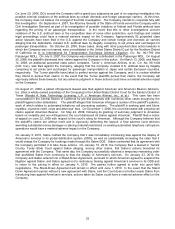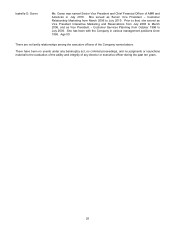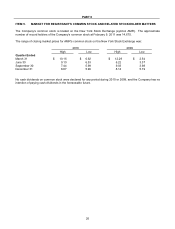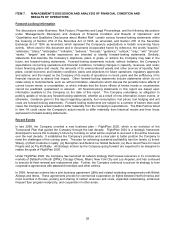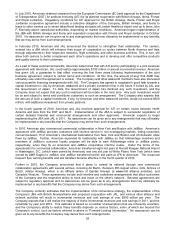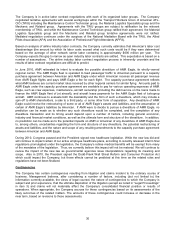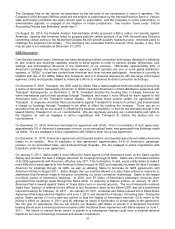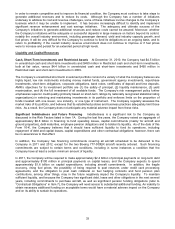American Airlines 2010 Annual Report Download - page 36
Download and view the complete annual report
Please find page 36 of the 2010 American Airlines annual report below. You can navigate through the pages in the report by either clicking on the pages listed below, or by using the keyword search tool below to find specific information within the annual report.
33
In order to remain competitive and to improve its financial condition, the Company must continue to take steps to
generate additional revenues and to reduce its costs. Although the Company has a number of initiatives
underway to address its cost and revenue challenges, some of these initiatives involve changes to the Company’s
business which it may be unable to implement. It has become increasingly difficult to identify and implement
significant revenue enhancement and cost savings initiatives. The adequacy and ultimate success of the
Company’s initiatives to generate additional revenues and reduce costs cannot be assured. Moreover, whether
the Company’s initiatives will be adequate or successful depends in large measure on factors beyond its control,
notably the overall industry environment, including passenger demand, yield and industry capacity growth, and
fuel prices. It will be very difficult for the Company to continue to fund its obligations on an ongoing basis, and to
return to profitability, if the overall industry revenue environment does not continue to improve or if fuel prices
were to increase and persist for an extended period at high levels.
Liquidity and Capital Resources
Cash, Short-Term Investments and Restricted Assets At December 31, 2010, the Company had $4.5 billion
in unrestricted cash and short-term investments and $450 million in Restricted cash and short-term investments,
both at fair value, versus $4.4 billion in unrestricted cash and short-term investments and $460 million in
Restricted cash and short-term investments in 2009.
The Company’s unrestricted short-term investment portfolio consist of a variety of what the Company believes are
highly liquid, low risk instruments including money market funds, government agency investments, repurchase
investments, short-term obligations, corporate obligations, bank notes, certificates of deposit and time deposits.
AMR’s objectives for its investment portfolio are (1) the safety of principal, (2) liquidity maintenance, (3) yield
maximization, and (4) the full investment of all available funds. The Company’s risk management policy further
emphasizes superior credit quality (primarily based on short-term ratings by nationally recognized statistical rating
organizations) in selecting and maintaining investments in its portfolio and enforces limits on the proportion of
funds invested with one issuer, one industry, or one type of instrument. The Company regularly assesses the
market risks of its portfolio, and believes that its established policies and business practices adequately limit those
risks. As a result, the Company does not anticipate any material adverse impact from these risks.
Significant Indebtedness and Future Financing Indebtedness is a significant risk to the Company as
discussed in the Risk Factors listed in Item 1A. During the last five years, the Company raised an aggregate of
approximately $8.8 billion in financing to fund operating losses, capital commitments (mainly for aircraft and
ground properties), debt maturities, employee pension obligations and to bolster its liquidity. As of the date of this
Form 10-K, the Company believes that it should have sufficient liquidity to fund its operations, including
repayment of debt and capital leases, capital expenditures and other contractual obligations; however, there can
be no assurances to that effect.
In addition, the Company has financing commitments covering all aircraft scheduled to be delivered to the
Company in 2011 and 2012, except for the two Boeing 777-300ER aircraft recently ordered. Such financing
commitments are subject to certain terms and conditions, including in some instances a condition that the
Company have at least a certain minimum amount of liquidity.
In 2011, the Company will be required to make approximately $2.4 billion of principal payments on long-term debt
and approximately $100 million in principal payments on capital leases, and the Company expects to spend
approximately $1.6 billion on capital expenditures, including aircraft commitments. In addition, the fragile
economy, rising fuel prices, the possibility of being required to post reserves under credit card processing
agreements, and the obligation to post cash collateral on fuel hedging contracts and fund pension plan
contributions, among other things, may in the future negatively impact the Company’s liquidity. To maintain
sufficient liquidity, and because the Company has significant debt, lease and other obligations in the next several
years, including commitments to purchase aircraft, as well as significant pension funding obligations (refer to
“Contractual Obligations” in Item 7), the Company will need access to substantial additional funding. An inability to
obtain necessary additional funding on acceptable terms would have a material adverse impact on the Company
and on its ability to sustain its operations.


